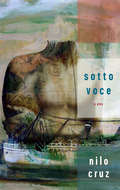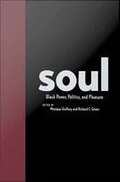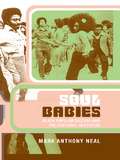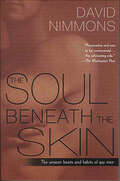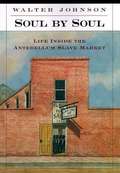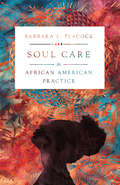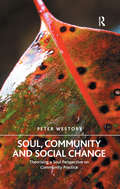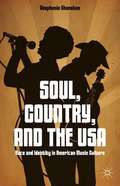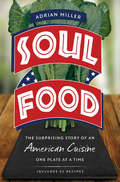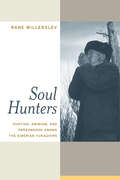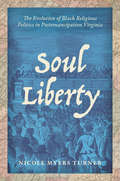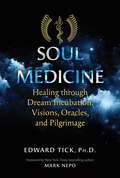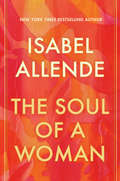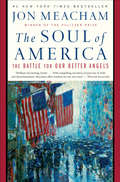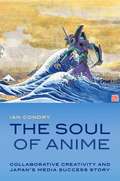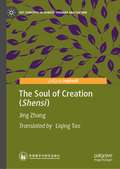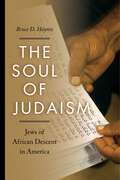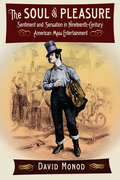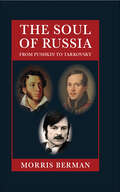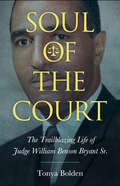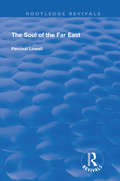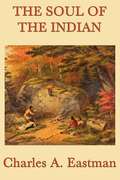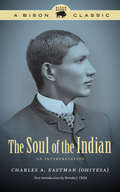- Table View
- List View
Sotto Voce (TCG Edition)
by Nilo Cruz"The poetry of Cruz's writing is what those who love his work cite most often about his style, and Sotto Voce has that. Yet it also contains passages that are realistic, whimsical, sensual and heartbreaking. Cruz may be that rarity, a poet of the stage, but he is first and foremost a dramatist."--The Miami HeraldAriel Strauss, a Jewish Cuban man, strives to explore his cultural history when he encounters Bemadette Kahn, an older woman and famed novelist who seeks to relive hers. Cruz's passionate romantic drama takes place in a dreamscape, somewhere between history and memory, present and past. Sotto Voce is a work of dramatic poetry and an imaginative exploration of nostalgia and the ensuing heartbreak it comes with.Nilo Cruz was the first Latino playwright to win the Pulitzer Prize for Drama for his play Anna in the Tropics. His other plays include Night Train to Bolina, Dancing on her Knees, A Park in Our House, Two Sisters and a Piano, The Color of Desire, Hurricane, A Bicycle Country, Hortensia and the Museum of Dreams, Lorca in a Green Dress, Beauty of the Father, and translations of Lorca's Doña Rosita the Spinster and The House of Bernarda Alba. He is the third recipient of the Greenfield Prize, a $30,000 grant to produce new work.
Soul
by Richard Green Monique GuilloryNo other word in the English language is more endemic to contemporary Black American culture and identity than "Soul". Since the 1960s Soul has been frequently used to market and sell music, food, and fashion. However, Soul also refers to a pervasive belief in the capacity of the Black body/spirit to endure the most trying of times in an ongoing struggle for freedom and equality. While some attention has been given to various genre manifestations of Soul-as in Soul music and food-no book has yet fully explored the discursive terrain signified by the term. In this broad-ranging, free-spirited book, a diverse group of writers, artists, and scholars reflect on the ubiquitous but elusive concept of Soul. Topics include: politics and fashion, Blaxploitation films, language, literature, dance, James Brown, and Schoolhouse Rock. Among the contributors are Angela Davis, Manning Marable, Paul Gilroy, Lyle Ashton Harris, Michelle Wallace, Ishmael Reed, Greg Tate, Manthia Diawara, and dream hampton.
Soul Babies: Black Popular Culture and the Post-Soul Aesthetic
by Mark Anthony NealIn Soul Babies, Mark Anthony Neal explains the complexities and contradictions of black life and culture after the end of the Civil Rights era. He traces the emergence of what he calls a "post-soul aesthetic," a transformation of values that marked a profound change in African American thought and experience. Lively and provocative, Soul Babies offers a valuable new way of thinking about black popular culture and the legacy of the sixties.
The Soul Beneath the Skin: The Unseen Hearts and Habits of Gay Men
by David NimmonsThis surprising and thought-provoking book begins with the obvious fact that Stonewall happened 30 years ago, and the perhaps less obvious fact that in the 30 years since an enormous number of social science studies have been done on gay men. Dave Nimmons proceeds to synthesize that information to reveal a number of unseen patterns of gay male behavior, truths about our lives we feel instinctively but have not named.For instance, countless studies show that gay men have developed a culture in which public violence is almost non-existent, which is notable when you consider that violence in this society is almost entirely a male phenomenon. Even in intensely over-crowded gay bars and discos, with alcohol and testosterone saturating the atmosphere, fist fights are virtually unheard of. On in the area of volunteerism, study after study shows that gay men volunteer at a much higher level than any other segment of the population (and, very interestingly, our volunteerism is about evenly divided between gay and non-gay causes, as are our charitable contributions). Our patterns of intimacy and friendship are much more diffuse and extended than heterosexual patterns; sexual jealousy and exclusiveness are extremely different, as are our relationships with women and our pursuit of playfulness and sexual bliss. Altogether, these gay social innovations have no parallel in modern American culture; they describe a new kind of public ethics, one with deep implications for gay men and for the larger society.
Soul by Soul: Life Inside the Antebellum Slave Market
by Walter JohnsonWinner of the Frederick Jackson Turner Award Winner of the John Hope Franklin Prize Winner of the Avery O. Craven Award Soul by Soul tells the story of slavery in antebellum America by moving away from the cotton plantations and into the slave market itself, the heart of the domestic slave trade. Taking us inside the New Orleans slave market, the largest in the nation, where 100,000 men, women, and children were packaged, priced, and sold, Walter Johnson transforms the statistics of this chilling trade into the human drama of traders, buyers, and slaves, negotiating sales that would alter the life of each. What emerges is not only the brutal economics of trading but the vast and surprising interdependencies among the actors involved. Using recently discovered court records, slaveholders’ letters, nineteenth-century narratives of former slaves, and the financial documentation of the trade itself, Johnson reveals the tenuous shifts of power that occurred in the market’s slave coffles and showrooms. Traders packaged their slaves by “feeding them up,” dressing them well, and oiling their bodies, but they ultimately relied on the slaves to play their part as valuable commodities. Slave buyers stripped the slaves and questioned their pasts, seeking more honest answers than they could get from the traders. In turn, these examinations provided information that the slaves could utilize, sometimes even shaping a sale to their own advantage. Johnson depicts the subtle interrelation of capitalism, paternalism, class consciousness, racism, and resistance in the slave market, to help us understand the centrality of the “peculiar institution” in the lives of slaves and slaveholders alike. His pioneering history is in no small measure the story of antebellum slavery.
Soul by Soul: Life Inside the Antebellum Slave Market
by Walter JohnsonSoul by Soul tells the story of slavery in antebellum America by moving away from the cotton plantations and into the slave market itself, the heart of the domestic slave trade. Taking us inside the New Orleans slave market, the largest in the nation, where 100,000 men, women, and children were packaged, priced, and sold, Walter Johnson transforms the statistics of this chilling trade into the human drama of traders, buyers, and slaves, negotiating sales that would alter the life of each. What emerges is not only the brutal economics of trading but the vast and surprising interdependencies among the actors involved. Using recently discovered court records, slaveholders' letters, nineteenth-century narratives of former slaves, and the financial documentation of the trade itself, Johnson reveals the tenuous shifts of power that occurred in the market's slave coffles and showrooms. Traders packaged their slaves by "feeding them up," dressing them well, and oiling their bodies, but they ultimately relied on the slaves to play their part as valuable commodities. Slave buyers stripped the slaves and questioned their pasts, seeking more honest answers than they could get from the traders. In turn, these examinations provided information that the slaves could utilize, sometimes even shaping a sale to their own advantage. Johnson depicts the subtle interrelation of capitalism, paternalism, class consciousness, racism, and resistance in the slave market, to help us understand the centrality of the "peculiar institution" in the lives of slaves and slaveholders alike. His pioneering history is in no small measure the story of antebellum slavery.
Soul Care in African American Practice
by Barbara L. PeacockIn the midst of our hectic, overscheduled lives, caring for the soul is imperative.
Soul, Community and Social Change: Theorising a Soul Perspective on Community Practice
by Peter WestobyAt a time when inequalities are growing globally, when the pace of socio-economic transitions is rapid, and when traditional ties of community are under threat of dissolving, 'soul' offers a new way of thinking imaginatively about how people might respond both individually and collectively in social change work. In exploring ideas such as soul, soulful, 'soul of the world' and soul-force, Peter Westoby invites readers to disrupt their taken-for-granted assumptions about community practice and to foreground ethics, quality, being and the aesthetic. Drawing on work of people such as James Hillman, Thomas Moore and 'Bifo' Beradi, he insists on the need to bring more depth into practice, eschewing contemporary trends of soulless analysis, measuring, and technique. Written in dialogue with eight practitioner-scholars from around the world, the book suggests a fresh terrain for community work and social change theorising. Illustrated by images of Australian cartoonist-prophet Michael Leunig, the book also promises to unlock new imaginative spaces for dreaming. A soul perspective will resonate with people searching for both a robust socio-political response to the world and an imaginative, poetic and mindful centring of self, 'other' and the planet to their practice.
Soul, Country, and the USA
by Stephanie ShonekanIn twenty-first century America, soul music and country music hold influential positions as the two central flagships that propel the expression and evolution of American popular culture. From their respective but concentric positions on opposite ends of the perpetual continuum of American racial identity, these musical cultures attract their audiences with their distinctive musical aesthetics and characteristically relatable cultural messages. Applying ethnomusicological tools, this book examines the socio-cultural influences and consequences of these two genres: the perception of and resistance to hegemonic structures from within their respective constituencies, the definition of national identity, and the understanding of the "American Dream. " These genres communicate coded information to their enthusiasts whose experiences and world views are formed and reinforced in this transaction between producers and consumers. Each emerging American reality revolves around a unique sub-culture that is replete with its own highly developed signifiers and undergirded by its own interpretation of identity, space, vernacular, and politics. In the midst of these divergent realities, these two musical cultures are direct descendants of a common ancestor. The southern Americana musical tradition, which emerged from the experience of poverty and working class struggle, serves as the cultural and aesthetic progenitor from which these genres and their associated cultural mores have derived.
Soul Food
by Adrian MillerIn this insightful and eclectic history, Adrian Miller delves into the influences, ingredients, and innovations that make up the soul food tradition. Focusing each chapter on the culinary and social history of one dish--such as fried chicken, chitlins, yams, greens, and "red drinks--Miller uncovers how it got on the soul food plate and what it means for African American culture and identity.Miller argues that the story is more complex and surprising than commonly thought. Four centuries in the making, and fusing European, Native American, and West African cuisines, soul food--in all its fried, pork-infused, and sugary glory--is but one aspect of African American culinary heritage. Miller discusses how soul food has become incorporated into American culture and explores its connections to identity politics, bad health raps, and healthier alternatives. This refreshing look at one of America's most celebrated, mythologized, and maligned cuisines is enriched by spirited sidebars, photographs, and 22 recipes.
Soul Hunters: Hunting Animism and Personhood among the Siberian Yukaghirs
by Rane WillerslevThis is an insightful, highly original ethnographic interpretation of the hunting life of the Yukaghirs, a little-known group of indigenous people in the Upper Kolyma region of northeastern Siberia. Basing his study on firsthand experience with Yukaghir hunters, Rane Willerslev focuses on the practical implications of living in a "hall-of-mirrors" world—one inhabited by humans, animals, and spirits, all of whom are understood to be endless mimetic doubles of one another. In this world human beings inhabit a betwixt-and-between state in which their souls are both substance and nonsubstance, both body and soul, both their own individual selves and reincarnated others. Hunters are thus both human and the animals they imitate, which forces them to steer a complicated course between the ability to transcend difference and the necessity of maintaining identity.
Soul Liberty: The Evolution of Black Religious Politics in Postemancipation Virginia
by Nicole Myers TurnerThat churches are one of the most important cornerstones of black political organization is a commonplace. In this history of African American Protestantism and American politics at the end of the Civil War, Nicole Myers Turner challenges the idea of black churches as having always been politically engaged. Using local archives, church and convention minutes, and innovative Geographic Information Systems (GIS) mapping, Turner reveals how freedpeople in Virginia adapted strategies for pursuing the freedom of their souls to worship as they saw fit—and to participate in society completely in the evolving landscape of emancipation. Freedpeople, for both evangelical and electoral reasons, were well aware of the significance of the physical territory they occupied, and they sought to organize the geographies that they could in favor of their religious and political agendas at the outset of Reconstruction. As emancipation included opportunities to purchase properties, establish black families, and reconfigure gender roles, the ministry became predominantly male, a development that affected not only discourses around family life but also the political project of crafting, defining, and teaching freedom. After freedmen obtained the right to vote, an array of black-controlled institutions increasingly became centers for political organizing on the basis of networks that mirrored those established earlier by church associations. We are proud to announce that this book will also be published as an enhanced open-access e-book on a companion website hosted by Fulcrum, an innovative publishing platform launched by Michigan Publishing at the University of Michigan Library. The Fulcrum version of the book can be located using this link: https://doi.org/10.5149/9781469655253_Turner.
Soul Medicine: Healing through Dream Incubation, Visions, Oracles, and Pilgrimage
by Edward TickAn in-depth look at ancient Greek practices for profound, lasting healing• Explores hidden soul-healing practices including dream incubation and interpretation as well as sacred pilgrimage• Examines how dreams, visions, and other non-normative events reveal the conditions needed to restore the soul and facilitate healing• Includes successful healing techniques, practices, and case studies to reveal how healings are achieved with these methodsThe modern practice of medicine and psychology grew out of the ancient Greek healing tradition, said to be founded by Asklepios, god of healing and dreams. For two thousand years the system spread all over the Mediterranean world and planted the roots of Western medicine and psychology by offering ritual and holistic practices that recognized that healing begins at the soul level. Yet, since that time, the spiritually based practices were cast aside, leaving behind only the scientific medical techniques that dominate health care today. Resurrecting and restoring the sacred, mythological, and cultural origins of medicine and psychotherapy, Edward Tick, Ph.D., explores the soul-healing practices missing in our contemporary health systems. He looks at the dream incubation tradition of Asklepios, sacred theater of Dionysos, oracle gifting of Apollo, special practices of warriors, and their roots in Neolithic shamanism and indigenous traditions. Demonstrating the ritual use of dreams, visions, oracles, synchronicities, and pilgrimage for healing and connecting to the transpersonal and divine, he explains how dream incubation is a technique in which you plant a seed for a specific healing or growth goal.Using both ancient wisdom and modern depth psychology alongside stories of healings from his more than 25 years of guiding Vietnam veterans on Greek pilgrimages, Tick explores how we all can use ancient healing philosophies and practices to achieve holistic healing today. He examines the interaction between mind and body (psyche and soma) and between physical illness and the soul to heal PTSD and trauma. He explains the art of making accurate and holistic interpretations of signs, symbols, and symptoms to determine what they reveal about the soul. Showing how dreams and other transpersonal experiences are essential components of soul medicine, the author reveals how restoration of the soul facilitates true healing.
The Soul of a Woman
by Isabel AllendeFrom the New York Times bestselling author of A Long Petal of the Sea comes a passionate and inspiring meditation on what it means to be a woman. <P><P>“When I say that I was a feminist in kindergarten, I am not exaggerating,” begins Isabel Allende. As a child, she watched her mother, abandoned by her husband, provide for her three small children without “resources or voice.” Isabel became a fierce and defiant little girl, determined to fight for the life her mother couldn’t have. <P><P>As a young woman coming of age in the late 1960s, she rode the second wave of feminism. Among a tribe of like-minded female journalists, Allende for the first time felt comfortable in her own skin, as they wrote “with a knife between our teeth” about women’s issues. She has seen what the movement has accomplished in the course of her lifetime. And over the course of three passionate marriages, she has learned how to grow as a woman while having a partner, when to step away, and the rewards of embracing one’s sexuality. <P><P>So what feeds the soul of feminists—and all women—today? To be safe, to be valued, to live in peace, to have their own resources, to be connected, to have control over our bodies and lives, and above all, to be loved. On all these fronts, there is much work yet to be done, and this book, Allende hopes, will “light the torches of our daughters and granddaughters with mine. They will have to live for us, as we lived for our mothers, and carry on with the work still left to be finished.”
The Soul of America: The Battle for Our Better Angels
by Jon MeachamPulitzer Prize–winning author Jon Meacham helps us understand the present moment in American politics and life by looking back at critical times in our history when hope overcame division and fear. <P><P>Our current climate of partisan fury is not new, and in The Soul of America Meacham shows us how what Abraham Lincoln called the “better angels of our nature” have repeatedly won the day. <P>Painting surprising portraits of Lincoln and other presidents, including Ulysses S. Grant, Theodore Roosevelt, Woodrow Wilson, Franklin D. Roosevelt, Harry S. Truman, Dwight Eisenhower, and Lyndon B. Johnson, and illuminating the courage of such influential citizen activists as Martin Luther King, Jr., early suffragettes Alice Paul and Carrie Chapman Catt, civil rights pioneers Rosa Parks and John Lewis, First Lady Eleanor Roosevelt, and Army-McCarthy hearings lawyer Joseph N. Welch, Meacham brings vividly to life turning points in American history. <P>He writes about the Civil War, Reconstruction, and the birth of the Lost Cause; the backlash against immigrants in the First World War and the resurgence of the Ku Klux Klan in the 1920s; the fight for women’s rights; the demagoguery of Huey Long and Father Coughlin and the isolationist work of America First in the years before World War II; the anti-Communist witch-hunts led by Senator Joseph McCarthy; and Lyndon Johnson’s crusade against Jim Crow. <P>Each of these dramatic hours in our national life have been shaped by the contest to lead the country to look forward rather than back, to assert hope over fear—a struggle that continues even now. <P>While the American story has not always—or even often—been heroic, we have been sustained by a belief in progress even in the gloomiest of times. <P>In this inspiring book, Meacham reassures us, “The good news is that we have come through such darkness before”—as, time and again, Lincoln’s better angels have found a way to prevail. <P><b>A New York Times Bestseller</b>
The Soul of Anime: Collaborative Creativity and Japan's Media Success Story
by Ian CondryIn The Soul of Anime, Ian Condry explores the emergence of anime, Japanese animated film and television, as a global cultural phenomenon. Drawing on ethnographic research, including interviews with artists at some of Tokyo's leading animation studios--such as Madhouse, Gonzo, Aniplex, and Studio Ghibli--Condry discusses how anime's fictional characters and worlds become platforms for collaborative creativity. He argues that the global success of Japanese animation has grown out of a collective social energy that operates across industries--including those that produce film, television, manga (comic books), and toys and other licensed merchandise--and connects fans to the creators of anime. For Condry, this collective social energy is the soul of anime.
The Soul of Creation (Key Concepts in Chinese Thought and Culture)
by Jing ZhangThis Key Concepts pivot explores the aesthetic concept of ‘imaginative contemplation.’ Drawing on key literature to provide a comprehensive and systematic study of the term, the book offers a unique analysis and definition of the connotations of the term, describing its aesthetic mentality and examining the issue of imaginative contemplation versus imagination in artistic creative thinking, especially as regards the characteristics of contingent thinking in aesthetics. It focuses on drawing parallels between imaginative contemplation and aesthetic emotions, aesthetic rationality, and artistic expression as well as aesthetic form. Examining the relationship between imaginative contemplation and the aesthetic configuration, the book provides a valuable introduction to aesthetic theory in Chinese philosophy and art.
The Soul of Judaism: Jews of African Descent in America (Religion, Race, and Ethnicity)
by Bruce D HaynesA study of the history of Black Jews in the United States and the counter-narratives they have put forward as they stake their claims to Jewishness.The Soul of Judaism offers the first exploration of the full diversity of Black Jews, including bi-racial Jews of both matrilineal and patrilineal descent; adoptees; black converts to Judaism; and Black Hebrews and Israelites, who trace their Jewish roots to Africa and challenge the dominant western paradigm of Jews as white and of European descent. Blending historical analysis and oral history, Haynes showcases the lives of Black Jews within the Orthodox, Conservative, Reconstruction and Reform movements, as well as the religious approaches that push the boundaries of the common forms of Judaism we know today. He illuminates how in the quest to claim whiteness, American Jews of European descent gained the freedom to express their identity fluidly while African Americans have continued to be seen as a fixed racial group. This book demonstrates that racial ascription has been shaping Jewish selfhood for centuries. Pushing us to reassess the boundaries between race and ethnicity, it offers insight into how Black Jewish individuals strive to assert their dual identities and find acceptance within their respective communities. Putting to rest the simplistic notion that Jews are white and that Black Jews are therefore a contradiction, the volume argues that we can no longer pigeonhole Black Hebrews and Israelites as exotic, militant, and nationalistic sects outside the boundaries of mainstream Jewish thought and community life. The volume spurs us to consider the significance of the growing population of self-identified Black Jews and its implications for the future of American Jewry.
The Soul of Pleasure: Sentiment and Sensation in Nineteenth-Century American Mass Entertainment
by David MonodShow business is today so essential to American culture it's hard to imagine a time when it was marginal. But as David Monod demonstrates, the appetite for amusements outside the home was not "natural": it developed slowly over the course of the nineteenth century. The Soul of Pleasure offers a new interpretation of how the taste for entertainment was cultivated. Monod focuses on the shifting connection between the people who built successful popular entertainments and the public who consumed them. Show people discovered that they had to adapt entertainment to the moral outlook of Americans, which they did by appealing to sentiment.The Soul of Pleasure explores several controversial forms of popular culture—minstrel acts, burlesques, and saloon variety shows—and places them in the context of changing values and perceptions. Far from challenging respectability, Monod argues that entertainments reflected and transformed the audience’s ideals. In the mid-nineteenth century, sentimentality not only infused performance styles and the content of shows but also altered the expectations of the theatergoing public. Sentimental entertainment depended on sensational effects that produced surprise, horror, and even gales of laughter. After the Civil War the sensational charge became more important than the sentimental bond, and new forms of entertainment gained in popularity and provided the foundations for vaudeville, America’s first mass entertainment. Ultimately, it was American entertainment’s variety that would provide the true soul of pleasure.
The Soul of Russia: From Pushkin to Tarkovsky
by Morris Berman"Ecstasy, witchcraft, bewilderment-these ten loving vignettes on scandalous corners of Russian culture, by one of our most seasoned cultural critics, are a tribute to imperishable art even in our catastrophic time." -Caryl Emerson, Professor Emerita of Slavic Languages and Literatures, Princeton University In terms of literature, music, and film, it would be hard to outdo the sheer genius and creativity of Russia. These things constitute the soul of the nation, and it is this that Morris Berman explores in his latest work, The Soul of Russia. His central argument is that at the heart of this brilliance lies a particular idiosyncratic theme: the peasant-shamanic-folkloric tradition of the Russian people, which these artists, from Pushkin to Tarkovsky, drew upon for their inspiration. It was a "Dionysian" source, a nonrational one, and it endowed Russian creative work with what we would have to call vibrancy. Berman presents ten Russian artists who have left their indelible imprint on our collective consciousness. Pushkin offers a supernatural puzzle that Russian scholars are still trying to solve to this day. Gogol tells a tale of a man who wakes up to discover he has lost his nose, and goes in search of it-while his nose has simultaneously taken on a life of its own. Andrei Bely, in Petersburg, explains the revolution of 1905 not through traditional sociological or historical analysis, but by means of a surreal panorama of Oedipal events. Chekhov wittily explores the erotic properties of food, while Diaghilev shocks Europe with the great Vaslav Nijinsky and the Ballets Russes. Composing for this radical dance company, Stravinsky manages to alter the face of music forever. Mikhail Bulgakov offers one of the greatest novels of the twentieth century, The Master and Margarita, and Tarkovsky responds to Stanley Kubrick's famous 2001: A Space Odyssey by coming up with Solaris, a film based not on superficial American techno-fetishism but on questions of love, reality, and human identity. The Soul of Russia is a feast for the mind, but also for the senses-a book that readers will want to delve into more than once.
Soul of the Court: The Trailblazing Life of Judge William Benson Bryant Sr. (Margaret Walker Alexander Series in African American Studies)
by Tonya BoldenLegal legend Judge Louis F. Oberdorfer once stated that there were “only two people in the world who really understood the Constitution” and its impact on American lives. One was Hugo Black, deceased Supreme Court justice. The other was William Benson Bryant Sr. (1911–2005), who in the early 1950s became the first Black assistant US attorney to try cases in Washington, DC’s federal court, and became that same court’s first Black chief judge in 1977. Written by award-winning author Tonya Bolden, Soul of the Court: The Trailblazing Life of Judge William Benson Bryant Sr. presents the story of Bryant’s remarkable, pioneering life in the law—one that began in a segregated DC and included many years as an extraordinary criminal defense attorney, most notably as the dogged defender of Andrew Mallory, a young poor Black man sentenced to the electric chair for the 1954 rape of a white woman. Bryant fought for Mallory’s life all the way to the US Supreme Court, chiefly on the grounds that Mallory’s confession—the most damning evidence against him—was the fruit of an illegal detention. The High Court overturned Mallory’s conviction. Mallory v. United States was among the cases that culminated in the landmark 1966 Miranda rule.Appointed to federal judicial service by Lyndon B. Johnson in 1965, Bryant’s forty-year tenure included cases ranging from overturning a corrupted election of the United Mine Workers and unconstitutional conditions at the DC jail. The biography draws upon an array of documents, newspaper articles, and interviews with the judge’s friends, colleagues, and family members, as well as oral histories, including Judge Bryant’s. Bolden beautifully narrates the story of a life of compassion, unparalleled integrity, and unwavering belief in the dignity of every human being.
The Soul of the Far East (Routledge Revivals)
by Percival LowellFirst published in 1908, this volume explored Japanese culture and society for British readers in the wake of the Anglo-Japanese treaty of 1902. Japan’s recent victory over the Russian Empire in the Russo-Japanese war in 1904-5 had represented the first victory of an Asian power over its Western counterpart. Japan’s resulting parity is reflected both in the treaty and in the author’s conviction that Britain and Japan, though in many ways diametric opposites, could inform and enlighten one another. The two powers, Lowell argues, could work together to the benefit of both peoples. As the 1854 Convention of Kanagawa, in which Japan had abandoned isolation, remained recent, British awareness of Japan and its culture was still in its early stages. Percival Lowell sought to explore and communicate the culture of Britain’s new allies through areas such as its language, social structures, art and religion along with 32 illustrations.
The Soul of the Indian
by Charles A. EastmanEastman was a Native American physician, writer, national lecturer, and reformer. He was of Santee Sioux and Anglo-American ancestry. Active in politics and issues on American Indian rights, he worked to improve the lives of youths and founded 32 Native American chapters of the Young Men's Christian Association (YMCA). He also helped found the Boy Scouts of America. He is considered the first Native American author to write American history from the native point of view.
The Soul of the Indian: An Interpretation (The\reincarnation Library)
by Charles A. EastmanThe Soul of the Indian is Charles A. Eastman&’s exploration and documentation of religion as he experienced it during the late nineteenth century. A Dakota physician and writer who sought to bring understanding between Native and non-Native Americans, Eastman (1858–1939) became one of the best-known Native Americans of his time and a significant intellectual figure whose clarity of vision endures today. In a straightforward manner Eastman emphasizes the universal quality and personal appeal of his Dakota religious heritage. First published in 1911, The Soul of the Indian draws on his childhood teaching and ancestral ideals to counter the research written by outsiders who treated the Dakotas&’ ancient worldviews chiefly as a matter of curiosity. Eastman writes with deep respect for his ancestors and their culture and history, including a profound reverence for the environment, animals, and plants. Though written more than a century ago, Eastman could be speaking to our own time with its spiritual confusion and environmental degradation. The new introduction by Brenda J. Child grounds this important book in contemporary studies.

